Consider the popular casino game of craps, in which a player throws two dice and bets on
Question:
Consider the popular casino game of craps, in which a player throws two dice and bets on the outcome (the sum total of the dots showing on the upper faces of the two dice). In Example 4.5 (p. 218), we looked at the possible outcomes of a $5 wager on the first toss (called the come-out roll). Recall that if the sum total of the dice is 7 or 11, the roller wins $5; if the total is a 2, 3, or 12, the roller loses $5 (i.e., the roller “wins” - $5);
and, for any other total (4, 5, 6, 8, 9, or 10), no money is lost or won on that roll (i.e., the roller wins $0). Let x represent the result of the come-out roll wager (- $5, $0, or + $5).
We showed in Example 4.5 that the actual probability distribution of x is:
Outcome of wager, x -5 0 5 p(x) 1>9 6>9 2>9 Now, consider a random sample of n = 3 come-out rolls.
a. Find the sampling distribution of the sample mean, x.
b. Find the sampling distribution of the sample median, M.
Step by Step Answer:






